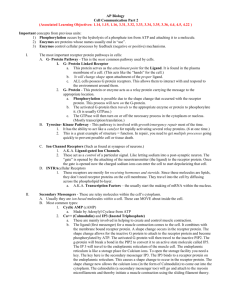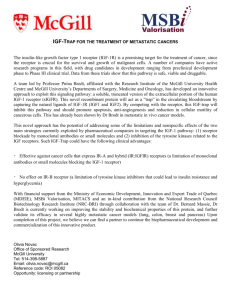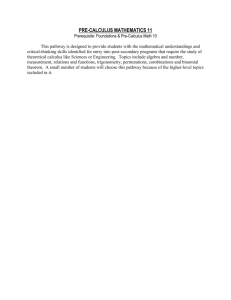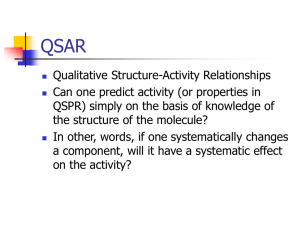1.4 Cell Communication - Brindlee Mountain High School
advertisement
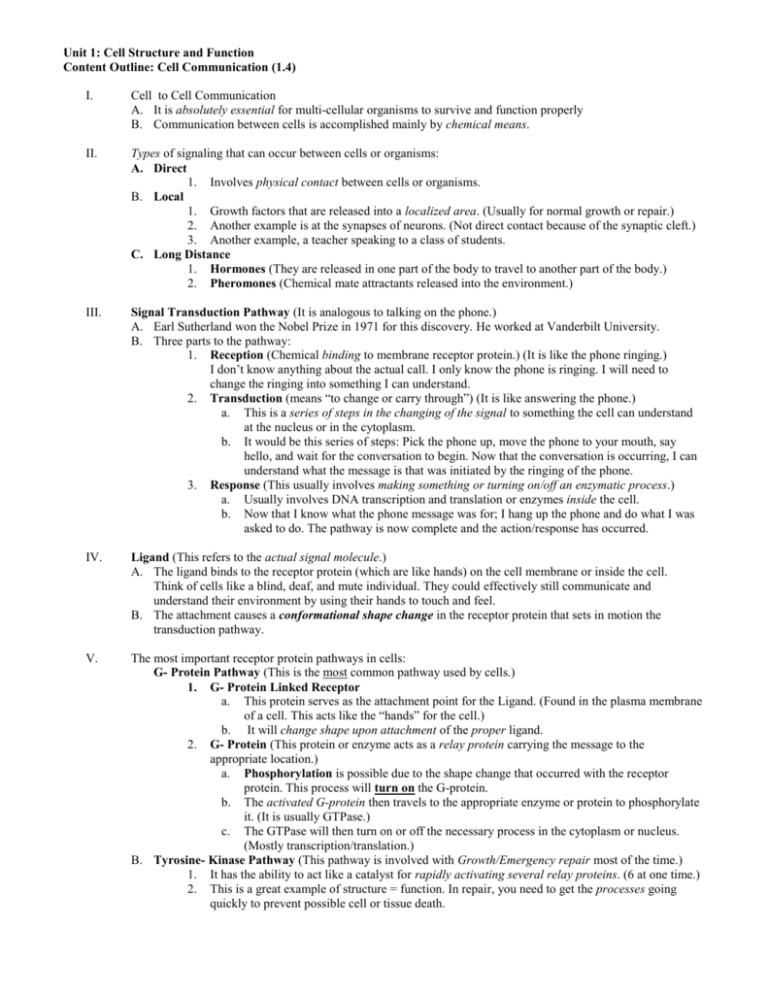
Unit 1: Cell Structure and Function Content Outline: Cell Communication (1.4) I. Cell to Cell Communication A. It is absolutely essential for multi-cellular organisms to survive and function properly B. Communication between cells is accomplished mainly by chemical means. II. Types of signaling that can occur between cells or organisms: A. Direct 1. Involves physical contact between cells or organisms. B. Local 1. Growth factors that are released into a localized area. (Usually for normal growth or repair.) 2. Another example is at the synapses of neurons. (Not direct contact because of the synaptic cleft.) 3. Another example, a teacher speaking to a class of students. C. Long Distance 1. Hormones (They are released in one part of the body to travel to another part of the body.) 2. Pheromones (Chemical mate attractants released into the environment.) III. Signal Transduction Pathway (It is analogous to talking on the phone.) A. Earl Sutherland won the Nobel Prize in 1971 for this discovery. He worked at Vanderbilt University. B. Three parts to the pathway: 1. Reception (Chemical binding to membrane receptor protein.) (It is like the phone ringing.) I don’t know anything about the actual call. I only know the phone is ringing. I will need to change the ringing into something I can understand. 2. Transduction (means “to change or carry through”) (It is like answering the phone.) a. This is a series of steps in the changing of the signal to something the cell can understand at the nucleus or in the cytoplasm. b. It would be this series of steps: Pick the phone up, move the phone to your mouth, say hello, and wait for the conversation to begin. Now that the conversation is occurring, I can understand what the message is that was initiated by the ringing of the phone. 3. Response (This usually involves making something or turning on/off an enzymatic process.) a. Usually involves DNA transcription and translation or enzymes inside the cell. b. Now that I know what the phone message was for; I hang up the phone and do what I was asked to do. The pathway is now complete and the action/response has occurred. IV. Ligand (This refers to the actual signal molecule.) A. The ligand binds to the receptor protein (which are like hands) on the cell membrane or inside the cell. Think of cells like a blind, deaf, and mute individual. They could effectively still communicate and understand their environment by using their hands to touch and feel. B. The attachment causes a conformational shape change in the receptor protein that sets in motion the transduction pathway. V. The most important receptor protein pathways in cells: G- Protein Pathway (This is the most common pathway used by cells.) 1. G- Protein Linked Receptor a. This protein serves as the attachment point for the Ligand. (Found in the plasma membrane of a cell. This acts like the “hands” for the cell.) b. It will change shape upon attachment of the proper ligand. 2. G- Protein (This protein or enzyme acts as a relay protein carrying the message to the appropriate location.) a. Phosphorylation is possible due to the shape change that occurred with the receptor protein. This process will turn on the G-protein. b. The activated G-protein then travels to the appropriate enzyme or protein to phosphorylate it. (It is usually GTPase.) c. The GTPase will then turn on or off the necessary process in the cytoplasm or nucleus. (Mostly transcription/translation.) B. Tyrosine- Kinase Pathway (This pathway is involved with Growth/Emergency repair most of the time.) 1. It has the ability to act like a catalyst for rapidly activating several relay proteins. (6 at one time.) 2. This is a great example of structure = function. In repair, you need to get the processes going quickly to prevent possible cell or tissue death. C. Intracellular Receptors 1. These receptors are mostly for receiving hormones and steroids. (Since these molecules are lipids, they don’t need receptor proteins on the cell membrane. They travel into the cell by diffusing across the phospholipid bi-layer. a. A.K.A. Transcription Factors – the usually start the making of mRNA within the nucleus. VI. Protein Kinase Cascades A. Kinases turn on processes by phosphorylating the molecule. B. The point of the cascade is to amplify the signal. (It keeps cells from making excess ligand signals. We only need one molecule to activate a process in that cell.) C. Each step in the cascade can amplify a signal; but it can also control the reaction rate of the process. VII. Protein Phosphatase Cascades A. Turn off processes by removing a phosphate ion from the molecule. B. Same as “B” and “C” above. VIII. Cellular Response A. The end product of the pathway is about the regulation of some cell process. 1. The responses are usually protein synthesis or product synthesis. (Turning them on/off.) IX. Amplification of the Signal A. Only need small amount of the ligand to convey the message. (This conserves energy and materials.) B. The cascades amplify the signal at each step. (1 becomes 2. 2 becomes 4. 4 becomes 8, and so forth.)
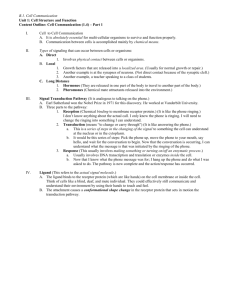
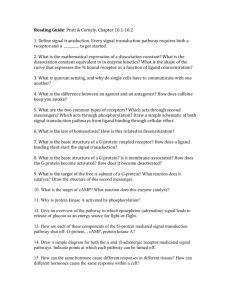
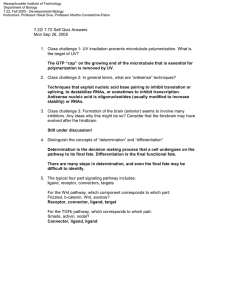




![Major Change to a Course or Pathway [DOCX 31.06KB]](http://s3.studylib.net/store/data/006879957_1-7d46b1f6b93d0bf5c854352080131369-300x300.png)
